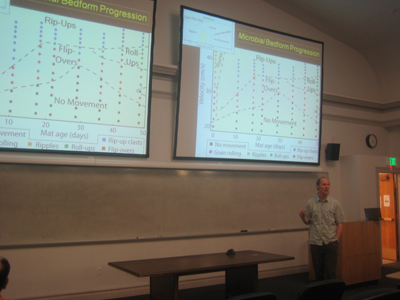No matter the scientific discipline, there will always be new data. It is when this data challenges models held for nearly a century that the fun begins. It was on this subject that Dr. James Hagadorn, Curator of Earth Sciences at the Denver Museum of Nature and Science, came to speak for the Van Tuyl lecture this past Thursday.
To understand the gist of the lecture, it is first necessary to define the world during the Late Proterozoic and Early Cambrian periods. Unlike the large, densely vegetated continents of today, long ago the only life on the land was essentially pond scum and fungi. While there was complex life, it inhabited the plentiful seas and oceans. “Most continents were not covered in this green mucky stuff,” said Hagadorn. “Beaches and landmasses were dominated by quartz sand.” Along with this lack of vegetation, the landforms were quite different. From current records, there is very little evidence for ice caps, though large continents such as Laurentia were beginning to form from the island chains that dominated the first half of Earth’s history. “I am not saying there were giant forests, but there is mounting evidence to suggest that there was a revolution of colonization by microbes,” revealed Hagadorn. The repercussions of this lack of large-scale life on surface is multi-faceted, but for the purposes of the lecture, the effect of plant life on erosion and on beaches was the prime focus.
For simple work, modern sedimentologists rely heavily upon the work of Filip Hjulström to determine what the aquatic environment was like in the timescale they are studying. While accurate for clean systems that are devoid of microbial life, Hagadorn has begun work on determining what effect ancient microbes may have had on sedimentary features. “So we have microbes, what does it mean? So what? We don’t know what effect these microbes have on these settings.” Based off of the work coming in, it would appear Hagadorn and his team may be close to reaching an understanding of these unknown effects.
The importance of knowing the aquatic environment and the effects of these microbes is multi-fold. First off, the more we understand the past of our planet, the more we can understand how it got the way it is today. By finding out how the seashores were, we can determine what life was like when it first began to move on to the land and for what reason this movement occurred. Second, were there large scale microbial colonies, there may be reason to start looking in more diverse, unconventional places for resources such as fuels or microbial based minerals.
Through dedicated research, Hagadorn and his team set out to recreate some of the features that had been seen in ancient sedimentary rocks through the implementation of microbial mats. “We took a bunch of sand and went over to the greenhouse and grew some [microbial] colonies of different flavors,” said Hagadorn. After a few microbial colonies had been grown, it was time to subject them to the wave tank. Without the bonding forces of microbial mats, sedimentary structures act in a very logical way. They form ripples at lower speed and as speed is increased, new features such as underwater dunes form. Much to the surprise of his team, some of the new sedimentary features were familiar. “Here are some of the features we were able to make and here they are in the rocks, we can now say something other than oh [there are] microbes there,” proclaimed Hagadorn, “we can now use them as tools to interpret what was going on in those environments.”
Another important aspect of Hagadorn’s research focused on life other than the microbial mats that proved opportune. Hagadorn asked, “Why would you go on land if the water was so nice? [It turns out] microbes went first and the animals followed. In almost all cases the animals follow the food sources.” Given that the oceans were full of predators, it would make sense that microbes that could move to shallow water or even on to land would have an advantage. As more food sources went to shore, prey followed and made their presence known. Where most burrowing creatures throughout life’s history burrow down, making vertical holes and trace fossils, after looking at some of the rock units, the team began finding horizontal burrows. At this point in the presentation, Hagadorn put up an image of a traditional core and asked the audience to point out the burrow. Much to the surprise of the geoscientists, the burrow was almost invisible near the top of the core. The purpose of this trick was effective. If there were burrows on the surface, the ability for the rock to trap hydrocarbons or groundwater would be significantly different.
The presentation ended by stressing the apparent importance of such a find to the perspective of the future. Hagadorn reflected on his own enthusiasm, “For me, this is all exciting, it means we have more to get done, we have a bright future for understanding and refining the models.” The significance of this finding was brought outside of the realm of the studied rock type. Given that the specific variety of sandstone only makes up around thirty percent of the earth’s old rocks, there are still other rock types that need to be looked at for microbial impact. On a more exciting tangent, the perspective of other planets was also mentioned. While no life has been found on Mars yet, it is known that there were hydrological processes on Mars in its past and by perfecting the current model, it will be possible for future martianauts to reference this research and possibly find evidence of microbial life from trace fossils or through pyrite layers.



'Van Tuyl lecture: Redefining earth’s microbial past' has no comments
Be the first to comment this post!